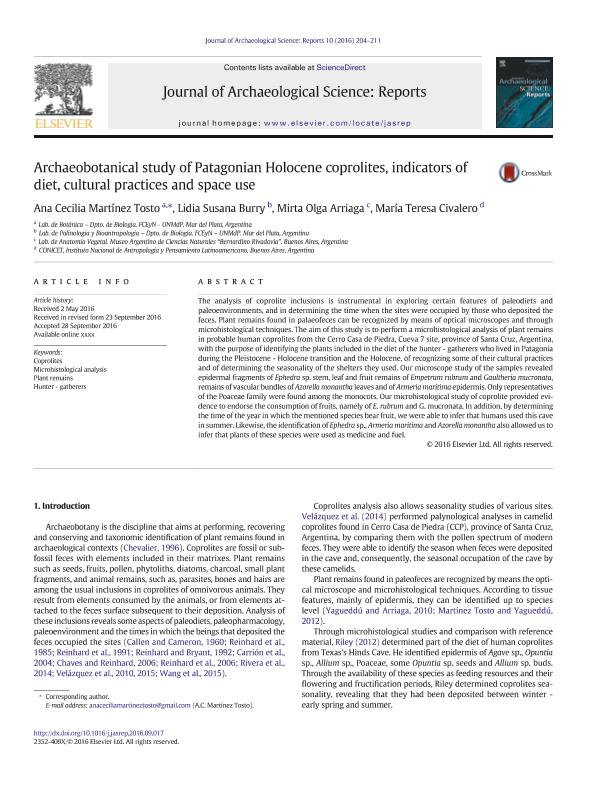Mostrar el registro sencillo del ítem
dc.contributor.author
Martínez Tosto, Ana Cecilia

dc.contributor.author
Burry, Lidia Susana

dc.contributor.author
Arriaga, Mirta Olga

dc.contributor.author
Civalero, Maria Teresa

dc.date.available
2020-11-04T15:28:45Z
dc.date.issued
2016-12
dc.identifier.citation
Martínez Tosto, Ana Cecilia; Burry, Lidia Susana; Arriaga, Mirta Olga; Civalero, Maria Teresa; Archaeobotanical study of Patagonian Holocene coprolites, indicators of diet, cultural practices and space use; Academic Press Ltd - Elsevier Science Ltd; Journal of Archaeological Science; 10; 12-2016; 204-211
dc.identifier.issn
0305-4403
dc.identifier.uri
http://hdl.handle.net/11336/117609
dc.description.abstract
The analysis of coprolite inclusions is instrumental in exploring certain features of paleodiets and paleoenvironments, and in determining the time when the sites were occupied by those who deposited the feces. Plant remains found in palaeofeces can be recognized by means of optical microscopes and through microhistological techniques. The aim of this study is to perform a microhistological analysis of plant remains in probable human coprolites from the Cerro Casa de Piedra, Cueva 7 site, province of Santa Cruz, Argentina, with the purpose of identifying the plants included in the diet of the hunter - gatherers who lived in Patagonia during the Pleistocene - Holocene transition and the Holocene, of recognizing some of their cultural practices and of determining the seasonality of the shelters they used. Our microscope study of the samples revealed epidermal fragments of Ephedra sp. stem, leaf and fruit remains of Empetrum rubrum and Gaultheria mucronata, remains of vascular bundles of Azorella monantha leaves and of Armeria maritima epidermis. Only representatives of the Poaceae family were found among the monocots. Our microhistological study of coprolite provided evidence to endorse the consumption of fruits, namely of E. rubrum and G. mucronata. In addition, by determining the time of the year in which the mentioned species bear fruit, we were able to infer that humans used this cave in summer. Likewise, the identification of Ephedra sp., Armeria maritima and Azorella monantha also allowed us to infer that plants of these species were used as medicine and fuel.
dc.format
application/pdf
dc.language.iso
eng
dc.publisher
Academic Press Ltd - Elsevier Science Ltd

dc.rights
info:eu-repo/semantics/openAccess
dc.rights.uri
https://creativecommons.org/licenses/by-nc-sa/2.5/ar/
dc.subject
COPROLITES
dc.subject
HUNTER - GATHERERS
dc.subject
MICROHISTOLOGICAL ANALYSIS
dc.subject
PLANT REMAINS
dc.subject.classification
Otras Ciencias de la Tierra y relacionadas con el Medio Ambiente

dc.subject.classification
Ciencias de la Tierra y relacionadas con el Medio Ambiente

dc.subject.classification
CIENCIAS NATURALES Y EXACTAS

dc.title
Archaeobotanical study of Patagonian Holocene coprolites, indicators of diet, cultural practices and space use
dc.type
info:eu-repo/semantics/article
dc.type
info:ar-repo/semantics/artículo
dc.type
info:eu-repo/semantics/publishedVersion
dc.date.updated
2020-11-02T17:04:30Z
dc.journal.volume
10
dc.journal.pagination
204-211
dc.journal.pais
Países Bajos

dc.description.fil
Fil: Martínez Tosto, Ana Cecilia. Universidad Nacional de Mar del Plata. Facultad de Ciencias Exactas y Naturales. Departamento de Biología; Argentina
dc.description.fil
Fil: Burry, Lidia Susana. Universidad Nacional de Mar del Plata. Facultad de Ciencias Exactas y Naturales. Departamento de Biología; Argentina
dc.description.fil
Fil: Arriaga, Mirta Olga. Consejo Nacional de Investigaciones Científicas y Técnicas. Oficina de Coordinación Administrativa Parque Centenario. Museo Argentino de Ciencias Naturales "Bernardino Rivadavia"; Argentina
dc.description.fil
Fil: Civalero, Maria Teresa. Secretaría de Cultura de la Nación. Dirección Nacional de Cultura y Museos. Instituto Nacional de Antropología y Pensamiento Latinoamericano; Argentina. Consejo Nacional de Investigaciones Científicas y Técnicas; Argentina
dc.journal.title
Journal of Archaeological Science

dc.relation.alternativeid
info:eu-repo/semantics/altIdentifier/url/https://www.journals.elsevier.com/journal-of-archaeological-science-reports/
dc.relation.alternativeid
info:eu-repo/semantics/altIdentifier/doi/http://dx.doi.org/10.1016/j.jasrep.2016.09.017
Archivos asociados
